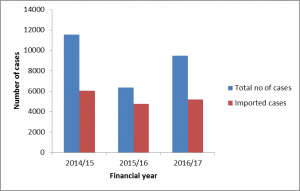Malaria Alert May 2017
There has been an increase in the number of malaria cases over the past few weeks. This is likely related to people travelling over the Easter holiday to malaria – risk areas both within South Africa (see malaria risk map) and to neighbouring countries. Noting that the incubation period for malaria is 10 – 14 days, travellers from both low and high malaria risk areas presenting with fever and flu-like symptoms must present at a healthcare facility or see their doctor for a malaria test even if chemoprophylaxis was taken. A negative malaria test must be treated cautiously and repeated. Any person with a travel history to a malaria risk area who presents with fever and flu-like symptoms is unlikely to have influenza at this time since the 2017 influenza season has not yet started.
There has been a high number of malaria cases in South Africa in the 2016/17 season compared to the previous season. This has been attributed to the rise in ambient temperature, rainfall and humidity. In the 2016/17 season, a total of 9478 malaria cases was reported, of which 5177 were imported cases. For the 2015/16 corresponding period, there were 6375 malaria cases, of which 4752 were imported. However, for the 2014/15 period, 11539 cases were reported, of which 6042 were imported (Figure 1). The total number of deaths for 2016/17 was 76, compared to 58 deaths last year and 130 deaths in the 2014/15 period. The lower number of cases seen for the 2015/16 period is a result of the drought experienced in that season. Limpopo Province has seen a proportionately high number of cases this season, with 1648 cases and 3 deaths. An outbreak was reported in Thabazimbi and Lephalale in the western Waterberg district of Limpopo Province in February and early March 2017.
Neighbouring countries have seen a similar trend of rising cases due to similar weather patterns to those affecting South Africa. Notably, significant malaria transmission has been reported in Mozambique, Zambia, Zimbabwe and Malawi; and parts of Botswana and Namibia. However, no increase in the number of cases was reported in Swaziland.
Malaria transmission is ongoing in South Africa and neighbouring countries. The number of cases is expected to rise as a result of travel and movement of people during the Easter holidays.
Travellers to malaria transmissions areas in South Africa (see malaria risk map), as well as to the neighbouring countries, are advised to take precautions. Travellers must consult with their doctors for anti-malarial chemoprophylaxis. Current recommended chemo-prophylactic regimens include mefloquine, doxycycline or atovaquone-proguanil. The consulting doctor will advise on the best option for each individual. It should be noted that whilst these medications are highly effective at preventing malaria, they are not 100% effective. All travellers, whether travelling to low or high risk areas, are advised to be aware of the malaria symptoms of fever, chills, sweats, headaches, nausea and vomiting, body aches, general malaise and yellow discolouration of eyes/skin, and to report to their nearest health facility or doctor if they suspect that they may have contracted malaria.

Fig 1. Malaria cases in South Africa for the financial years 2014/15, 2015/16 and 2016/17.




